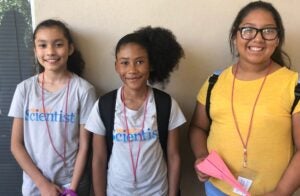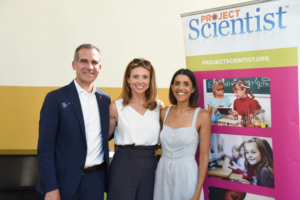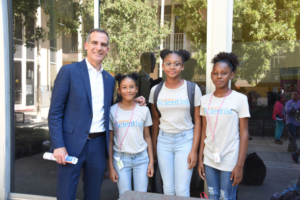 Increasing Representation, One Young Female Scientist at a Time
Increasing Representation, One Young Female Scientist at a Time
The USC Young Scientists Program hosts the Project Scientist Academy – Originally Published September 9, 2019
Two STEM education programs, the USC Young Scientists Program and Project Scientist, teamed up again this summer 2019. Project Scientist staff include a lot of women that have USC connections including CEO Sandy Marshall who graduated from USC in Public Policy 1996, Regina Ossey, the Chief Operating Officer, in 2005 who studied English Literature, and so it was a natural partnership to establish USC as a Project Scientist summer camp site. Project Scientist’s Summer STEM Academy immerses girls ages 4-12 in STEM through fun-filled experiments, weekly field trips to top science and technology companies, and daily interactive seminars with STEM Superstars — women thriving in the STEM field. Project Scientist’s credentialed teachers provide girls high-quality STEM education every day by delving into each subject with hands-on activities and experiments.
The Joint Educational Project’s Young Scientists Program helped to establish Project Scientist as a USC site in 2017 by hosting it and arranging for the classroom logistics. The Young Scientists Program (YSP) is an inquiry-based, hands-on Science, Technology, Engineering, Arts and Math (STEAM) educational outreach program operated by the USC Joint Educational Project. The program aims to address a critical lack of science education in JEP partner schools by recruiting STEAM undergraduate and graduate students to serve as Teaching Assistants (TAs). These TAs bring scientific laboratory experiences directly to students and their teachers, under the direction of the JEP STEM Programs Manager, Dieuwertje “DJ” Kast (also a USC alumna Biology 2011, Marine Environmental Biology MS 2011, Masters in Arts and Teaching (MAT) 2014, and current USC student doing an educational doctorate (EdD) in Teacher Education in Multicultural Societies in STEM), and individual YSP Site Coordinators. YSP targets students that are considered economically-disenfranchised, and racially and ethnically underrepresented in the health-related sciences, including African Americans, Latinx, and American Indians or Alaska Natives. The racial demographics of the students that would be participating in the program are the following: approximately 82% Latinx, 12.62% African American, and 0.1% Native American. As a host program, serving the Los Angeles community, YSP was able to recruit for the highly coveted scholarship candidate positions for Project Scientist Academy 2019.
Since 2017, the USC Project Scientist Academy has seen a steady increase in the number of scholarship pupils attending, with the vast majority of these students coming from Los Angeles Unified School District (LAUSD) schools that partner with YSP during the academic year. In this way, the social and educational goals, as well as the target demographic, of the Project Scientist Academy and the YSP are very much aligned: to increase representation of marginalized groups (including underrepresented minorities and women) in STEM professions, and to inspire young students in these marginalized groups to pursue further education in STEM fields.
Rita Barakat’s Narrative of her journey with Project Scientist and YSP:
Imagine sixty young girls filling the seats of a lecture hall on the University Park Campus of USC on a balmy, July morning. Excited chatter fills the room, and the older teenaged students help their much younger, first- and second-grade counterparts sit comfortably in the large, cushioned chairs as the presentation of one of this week’s “STEM Superstars” begins. These girls were all part of the Project Scientist 2017 USC Academy, and the theme for that particular week’s activities was “Coding and Computer Science”. I was invited to speak as a “STEM Superstar” by the 2017 Assistant Site Director for the academy, and USC Joint Educational Project’s STEM Programs Manager, DJ Kast, and eagerly awaited the arrival of the academy’s “pupils”, ranging in age from 4 to 14, so I could share with them what I use computer science for in my own work.
I was pleasantly surprised by the level of enthusiasm and attention I received from all the pupils, and many of their questions were not only specific to my area of focus (using computer programming to analyze functional MRI data), but were insightful and forward-thinking in nature, as though these pupils would themselves go on to conduct similar research of their own. After giving that presentation, I was quite convinced that many of those girls would in fact pursue and thrive in a STEM career, based on their scientific thinking, curiosity and diligence in their pursuit of knowledge. All of these attributes are at the center of the Project Scientist teaching philosophy, and pupils in the academy practice scientific logic and reasoning while experiencing hands-on, inquiry-based science learning in their classrooms and through Expeditions and STEM Superstar presentations.
I went on to teach for the Project Scientist Academy in the summers of 2018 and 2019, and had the immense pleasure and honor of instilling young girls (I worked primarily with students in grades pre-K through third) with a passion for and curiosity about scientific concepts. In between these two years of the Project Scientist Academy, I also served as the Program Assistant for the Young Scientists Program (YSP) through USC’s Joint Educational Project (JEP).
In addition to my own joint experiences with the YSP and Project Scientist Academy, the most recent Site Director of the USC Academy site, Jessica Stellman, has worked as a program assistant for YSP and other JEP programs, helping to create and update curriculum for the YSP K-5 educational program, as well as facilitate the expansion of YSP to more schools within the community. Jessica’s years of experience teaching and leading in K-5 STEM educational outreach, as well as her familiarity with the local community’s needs and values, made her an outstanding and highly empathetic director for this year’s Project Scientist Academy. She and I both had the opportunity to work with our scholarship students that have also participated in YSP during the academic year, and asked them about their experiences in both programs.
Scholarship Recipients:
Some of the students receiving the scholarship were: Emily Sanchez, Jaylyn Baldwin, and Destiny Ramirez. The girls mentioned, “Science here is so much fun!”.
DJ Kast, the Program Director for the YSP, as well as a previous Assistant Site Director for the USC Project Scientist Academy, has also been instrumental in allowing for the increased collaboration between these programs in accomplishing their shared goal of fostering greater female representation within STEM. She continues to champion the Project Scientist Academy as a distinguished partner program with the YSP, and will provide educational and leadership support for future academies that offer valuable scholarship opportunities to the community’s young, aspiring female scientists.
Summer 2019:
For the Project Scientist 2019 USC Academy, students embarked on a three-week journey of scientific exploration, focusing on three specific areas within STEM: “How It’s Made: Engineering and Design” (Week 1), “Transportation” (Week 2) and “DNA, Genetics and Dissections” (Week 3). For each week, students completed anywhere from eight to ten age-appropriate and NGSS-aligned lessons that each resulted in the creation of a final product which they could then use to demonstrate their learning as part of the “Parent Celebration” that concludes each week’s theme. Students also had the opportunity to meet three female professionals, or “STEM Superstars”, working in the field that matched the week’s theme. They also visited the workplaces of a number of these “STEM Superstars” as part of their weekly Expedition trip, which saw the girls visiting Suffolk Construction Company for their Engineering and Design week, JetBlue’s Terminal Office for their Transportation week, and MedTronic’s Irvine Headquarters for their DNA, Genetics and Dissections week.
Project Scientist partnered with a 3rd party, SheLeads, to conduct pre and post research to determine the effectiveness of the program…the results were positive. Results show signs that the students’ knowledge of STEM as a topic increased after Project Scientist. After Project Scientist, 85% more respondents gave the correct answer when asked to define STEM than before camp. In addition, the findings show Project Scientist encourages participants to associate women with STEM jobs and roles. At the conclusion of camp 36% more participants identified a woman when asked to identify a leader in STEM than before camp.
Future Collaborations
 Photo: Mayor Garcetti with CEO of Project Scientist Sandy Marshall, and Angelica, children’s mindfulness trainer from Atma Prema.
Photo: Mayor Garcetti with CEO of Project Scientist Sandy Marshall, and Angelica, children’s mindfulness trainer from Atma Prema.
The Los Angeles Mayor Eric Garcetti and his wife Amy Elaine Wakeland are big fans of Project Scientist.
“We like that girls as young as four years old can come to this summer science academy and think of themselves as scientists. Not only is the quality of the teaching very high, it’s also great fun. We also like the model of Project Scientist, which brings together a diverse group of girls from a variety of schools and background levels with like-minded goals and interests around the sciences. Our daughter Maya’s first camp ever was a sports medicine camp with Project Scientist when she was four. In all, she’s attended Project Scientist for 3 years and in particular loved the dissection camp this year. We believe Project Scientist is well worth the community’s support. It’s a vital force for educating the next generation of scientists and developing girls into scientific leaders.”
– Amy Elaine Wakeland, First Lady of Los Angeles
 Photo: Mayor Eric Garcetti poses with Jaylyn Baldwin, Jolie Hillman, Mya Hillman during a Parent Celebration for Project Scientist
Photo: Mayor Eric Garcetti poses with Jaylyn Baldwin, Jolie Hillman, Mya Hillman during a Parent Celebration for Project Scientist
The Mayor’s office Women in STEM initiative aka “WiSTEM” is working to partner with the Joint Educational Project to expand the Young Scientists Program to more classrooms and bring in more high-caliber female undergraduate and graduate students majoring in STEM to facilitate the delivery of STEM content to Title 1 schools. This partnership will work to illustrate the importance of gender equity in STEM and encourage all participating students to be leaders in STEM fields in the future.